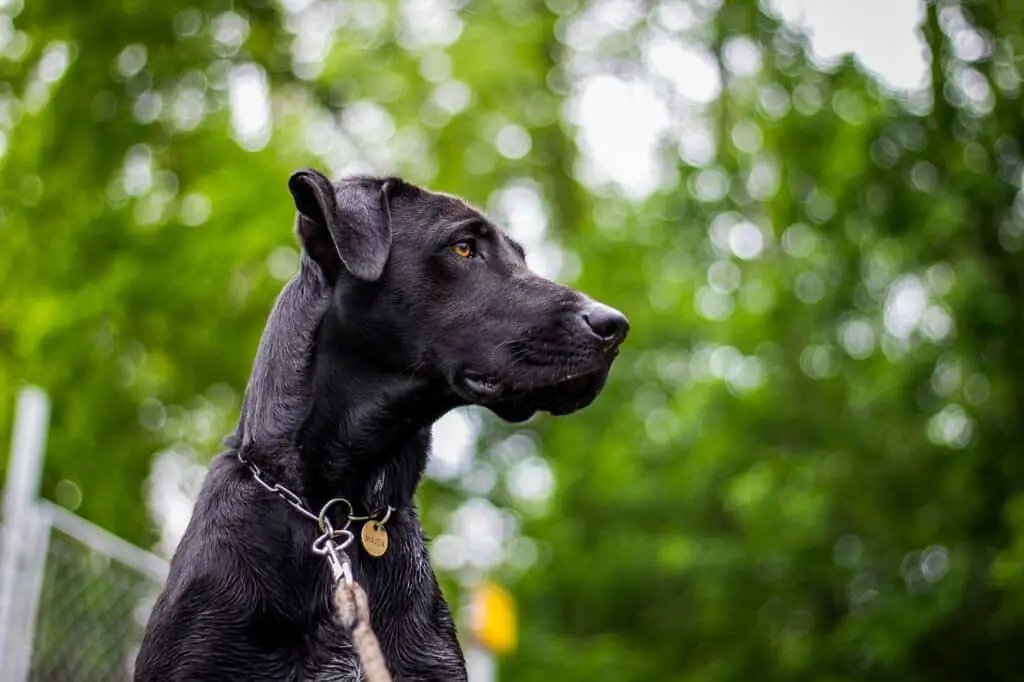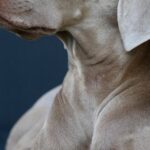Great Danes are known to be lovable, cuddly giants.
They also respond well to attention and affection, especially from children.
If you’re fortunate enough to have one of these dogs, you’ll want to know as much as possible about the breed to take good care of it.
For instance, knowing whether the Great Dane sheds will help ease some of the concerns related to owning the breed.
So, do Great Danes shed?
Yes, Great Danes have a moderate shedding pattern year-round, but it’s more pronounced in the spring.
They shed all over the house, especially on furniture and carpets.
So, you should keep up with good grooming once or twice a week if you want to avoid a houseful of hair.
It’ll also help keep their coat healthy and reduce shedding.
This article will help you learn more about the Great Dane’s shedding rate and why it sheds.
It’ll also cover how you can keep their shedding under control and ensure they look great all the time.

How Much Hair Does a Great Dane Shed?
The Great Dane is a massive breed of dog that can weigh up to 200 pounds.
It has a beautiful coat, as well.
Its hair type is classified as a single coat and sheds an average amount compared to other breeds.
However, it appears to shed more often due to its massive size.
The Great Dane’s coat comprises an outer layer called guard hair and an undercoat.
Guard hair is coarse and helps protect the undercoat.
The undercoat is soft, thick, and fluffy and keeps these dogs warm in cold weather.
When the weather gets warmer, the guard hair sheds in springtime, a process referred to as “blowing out.”
The undercoat grows back in time for winter.
As a result, it may produce excessive amounts of loose fur.
Consequently, your clothes and furniture are likely to have considerable hair on them.
However, this shedding process is normal and necessary to keep the dog’s skin healthy and clean.
The amount of sun your dog receives during the summer months will affect their fur growth.
It will also depend on how much sunburn your dog had.
A Great Dane that spends most of its days indoors or in shady areas with little sunlight exposure will most likely shed less than one exposed to the sun for long.
However, each dog will have different shedding levels depending on genetics and lifestyle.
Therefore, there will be some Great Danes that shed more than others.
Yet, even the most prolific shedders will only lose an average of one pound of hair per year.

Why Do Great Danes Shed?
As a Great Dane owner, you may notice your dog sheds quite a bit of hair.
In fact, some Great Danes shed so much that it’s almost impossible to keep up with the hairballs and clean-up.
This shedding can be frustrating when keeping up with all the hair in your house.
However, don’t be alarmed; that’s normal.
Shedding is a natural process that occurs in many pets, including dogs.
Your dog’s breed, health, and diet contribute to the amount and frequency of hair loss.
So, when your Great Dane has a lot of hair loss, it could indicate an underlying health issue, such as allergies or a poor diet.
Factors that Contribute to Grate Dane’s Shedding
Poor Diet
A poor diet can cause your Great Dane to shed more than usual.
It can affect their hair growth, coat quality, and shine.
A diet that is too high in fat or calories and lacks fiber can cause your dog to lose their fur and become itchy.
On the other hand, a healthy diet high in protein and low in fat can help keep your dog’s hair looking beautiful.
Danes are huge dogs, and their diet should reflect that.
A Dane’s daily caloric intake should be between 3000 and 4000 calories.
Seasons of the Year
The seasons can affect how much your dog sheds.
When there are changes in temperature and humidity in the spring and fall, you may notice more shedding than normal.
During that time, your Dane’s body adjusts to warmer temperatures, making them produce more hair than usual.
Health Issues
Danes may experience health issues that contribute to excessive shedding in their bodies.
For example, hypothyroidism can lead to excessive shedding if your dog’s thyroid gland is underactive.
A deficiency of thyroid hormone will cause the skin cells, called keratinocytes, to slow down their protein synthesis.
This results in hair loss, severe itching, and other symptoms like weight gain from poor metabolism and heat intolerance due to low body temperature.
Parasites
Parasites such as fleas can cause an allergic reaction in Great Danes, which triggers excessive hair loss and itching on their skin.
If your dog has parasites, have them treated for parasites before they start shedding again.
Then, they can return to their normal grooming routine.
Are Great Danes Hypoallergenic?
Great Danes are not hypoallergenic.
However, they have a short-haired coat that helps limit allergic reactions than other breeds with longer hair, like German Shepherds and Golden Retrievers.
Yet it can still trigger allergies in some people.
Hypoallergenic refers to a dog breed that produces less dander than other breeds.
Dander is dead skin cells that your dog sheds.
It can cause respiratory problems in susceptible people, including sneezing, runny nose, wheezing, and even asthma attacks.
While certain dog breeds are hypoallergenic, that doesn’t mean there aren’t any allergens present in their fur.
That dander they shed can still cause an allergic reaction even if it’s present in lower quantities.
So, if you’re looking for a dog that won’t trigger any allergies, even if it licks or sniffs at something, then Great Danes probably aren’t for you.
Tips to Reduce Shedding in Great Danes
The following tips can help you reduce your Great Dane’s shedding and keep your home clean.
Quality Diet
A quality diet can help reduce shedding because it keeps your Dane’s skin healthy and smooth.
Feed your dog a high-quality diet full of nutrients and amino acids to keep their skin and coat healthy.
For instance, foods containing omega fatty acids like salmon oil and plenty of protein sources like chicken or beef are excellent options.
These nutrients provide the building blocks for new cells in the skin and coat.
Bathing
Bathing is the most common way to reduce the amount of shedding.
It removes loose hair from your dog’s coat and keeps it from getting all over your home.
It’s recommended that you bathe your Dane once a week.
The bath should be warm and last no longer than 20 minutes.
If you have a dryer, use it on low heat after the bath to help your dog relax.
Brushing
Brushing helps spread natural oils throughout your Dane’s coat.
It also helps distribute the sebaceous glands’ secretions evenly across their skin.
As a result, it helps repair damaged hair follicles and keep them healthy.
Brush your dog when wet from a bath or shower.
Use a slicker brush, and brush with long strokes from head to tail for about five minutes per session.
It’ll help remove loose hair from the coat and reduce shedding when it falls out later on down the road.
Supplements
Supplements can be used in conjunction with a good diet to help promote healthy skin and coat growth and reduce shedding.
Supplements like biotin help create healthy skin cells that are less likely to break down prematurely or fall out prematurely.
Final Word
Great Danes are large dog breeds. Like other dogs of this type, these dogs shed heavily.
While Danes are warm in cold weather because of their coarse coat, they also shed a lot.
If you want one of these dogs, then, by all means, go for it.
Just be prepared to groom them regularly and provide a quality diet to minimize shedding.
It’ll also keep your home clean and free of loose hairs.
However, if you’ve allergies or cannot handle pet dander, this breed is not for you.
- What Dog Breeds Have Pink Skin? - March 24, 2023
- What Are the Most Inspiring Dog Breeding Quotes? - March 20, 2023
- Can Pheromone Spray Help Improve Dog Breeding Results? - March 19, 2023








